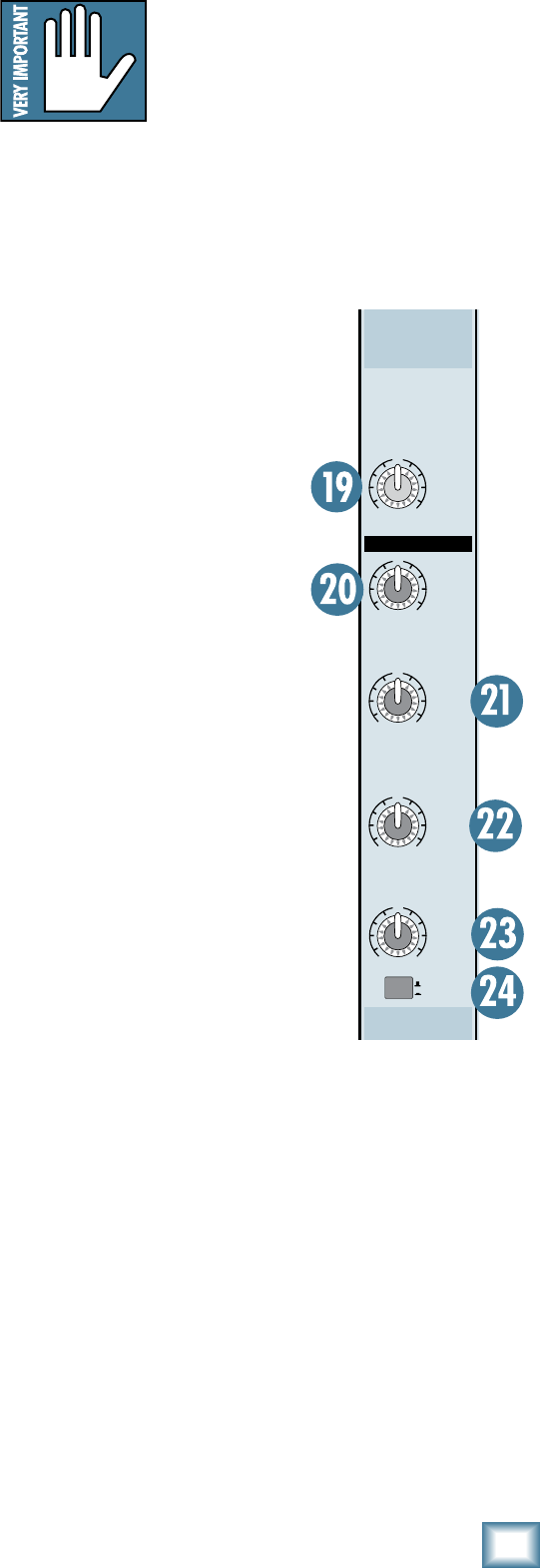
1
Owner’s Manual
Owner’s Manual
17. GROUP and MAIN MIX ASSIGN Switches
Alongside each channel fader are three buttons
referred to as channel assignment switches. Used in
conjunction with the channel’s PAN knob, they are used
to determine the destination of the channel’s signal.
With the PAN knob [13] at the center detent, the left
and right sides receive equal signal levels (GROUPS 1-2,
3-4, and MAIN MIX L-R). To feed only one side or the
other, turn the PAN knob accordingly.
If you’re doing a mixdown to a 2-track, for example,
simply engage the MAIN MIX switch on each channel
that you want to hear, and they’ll be sent to the MAIN
MIX bus. If you want to create a subgroup of certain
channels, engage either the 1-2 or 3-4 switches instead
of the MAIN MIX, and they’ll be sent to the appropriate
Group faders. From there, the groups can be sent back
to the MAIN MIX (using the MAIN MIX assign switches
[70] next to the Group faders), allowing you to use the
Group faders as a master control for those channels.
If you’re creating new tracks or bouncing existing ones,
you’ll also use the GROUP ASSIGN switches, but not the
MAIN MIX switch. Here, you don’t want the subgroups
sent back into the MAIN MIX bus, but sent out, via the
GROUP OUTS jacks [85], to your multitrack inputs. How-
ever, if you’re printing tracks via the DIRECT OUTS [76],
the channel assignment switches don’t matter because
the DIRECT OUTS come before the ASSIGN switches.
18. PFL SOLO Switch
This handy switch allows you to hear signals through
your headphones or monitor outputs without having to
route them to the MAIN or GROUP mixes. Folks use solo
in live work to preview channels before they are let into
the mix, or just to check out what a particular channel
is up to anytime during a session. You can solo as many
channels at a time as you like. It won’t affect what is
coming out the MAIN OUT or GROUP OUT jacks.
The Onyx 4•Bus has two solo modes. PFL (Pre-Fader
Listen) is the default solo mode, and the mode used for
inputs, including soloing individual channels and the
Stereo Returns. AFL (After-Fader Listen) is activated
whenever an AFL switch is pressed on an output, includ-
ing an Aux Send, Matrix, or Group.
PFL solo mode always overrides any AFL solo mode.
The Rude Solo LEDS [43] below the SOLO meters indi-
cate which solo mode is active.
Soloed channels are sent to the PHONES output and
MONITOR outputs, and also to the MAIN MIX meters.
PFL mode (Pre-Fader Listen) sends the channel’s signal
after the GAIN and EQ controls, but before the channel
fader, to the PFL solo bus (and appears on the LEFT
meter). AFL mode (After-Fader Listen), sends the
signal post-fader (and appears on the LEFT and RIGHT
meters), making it ideal for mixdown soloing.
VERY IMPORTANT: Remember, PFL
mode taps the channel signal before
the fader. If you have a channel’s fad-
er set way below “U” (unity gain), PFL
solo won’t know that and will send a
unity gain signal to the MONITOR OUT and PHONES
output. That may result in a startling level boost at
these outputs when switching to PFL solo mode.
Stereo Channel Strips
The Onyx 4•Bus mixers each have
two stereo channels. The stereo
channels have a pair of 1/4
"
TRS
line input connectors.
The stereo channels can be used
as mono or stereo line-input chan-
nel strips, or to return the signal
from an external effects processor
connected to an Aux Send (if you
want to apply EQ or more flex-
ible auxiliary routing to the signal
than is available with the Stereo
Returns). These versatile channel
strips are nearly as full-featured as
the mono channel strips.
1. GAIN Control
If you haven’t already, please
read “Set the Levels” on page 5.
The GAIN control adjusts the
input sensitivity of the stereo line
inputs. This allows the signal from
the outside world to be adjusted to
optimal internal operating levels.
There is 20 dB of attenuation
with
the knob turned all the way down,
ramping up to 20 dB of gain fully up, with a “U” (unity
gain) mark at 12:00.
0. HIGH EQ
This control gives you up to 15 dB boost or cut above
12 kHz, and it is also flat at the center detent. Use it to
add sizzle to cymbals, and an overall sense of transpar-
ency or edge to the keyboards, vocals, guitar, and bacon
frying. Turn it down a little to reduce sibilance, or to
hide tape hiss.
1. HIGH MID EQ
Short for “midrange,” this knob provides 15 dB of
boost or cut at 2.5 kHz. Midrange EQ is often thought of
as the most dynamic because the frequencies that de-
fine any particular sound are almost always found in this
'&
Z8
)&
(&
'&
EE
*&
+
+
K
,&
+&
Σ
ÎÓ
-/,"
,
*
BEM
C?
:
*&&>p
>?=>
C?
:
($+a>p
1
³£x
£x
1
³£x
£x
EKJ
?D
BEM
.&>p
1
³£x
£x
+
>?=>
'(a>p
1
³£x
£x
1
Óä`L ³Óä`L
18
*
)
(
'
+
,
""
8
""
8
""
8
""
8
""
8
""
8
"
³
£ä
ä
Óä
--
8
£
Ó
Î
{
Σ
ÎÓ
+
1/
*


















